This is part of our ongoing series The Game Design of Everyday Things. Also, I’m just going to presume you watch the show.
Like many of you, I was delighted to see Trammell Tillman on stage this week to receive an Emmy for Best Supporting Drama Actor at the Emmys. Tillman's performance as the inscrutable floor manager Seth Milchick in Apple TV+'s mystery show Severance has obviously been a real standout.
Severance is a show about many things, but it is principally about the many parts of ourselves and the lengths we go to divide them or consolidate them.“Playing Milchick is like putting on a suit of armor,” Tillman told Variety. “This man has layers upon layers upon layers, and every movement of Milchick is 100% intentional.”
I presume you're familiar with the show or you wouldn't be here. Still, for the uninitiated, humans can undergo a process named after the show that allows them to split their personalities into "innies" and "outies." Tillman's character, Milchick, oversees a floor of "severed" employees at the company Lumon that are working on a project of unknown provenance and purpose. It’s a bit of workplace drama and romance with a large helping of the surreal.
One thing that immediately jumped out at me was how much Severance felt like something in dialogue with games. The show's executive producer, Ben Stiller, hasn’t intimated the connection directly. Still, it’s not unreasonable that we as viewers well-steeped in the culture of games at a show through a game design is to be expected.

But why Severance specifically? I think it lends itself to a game-focused reading primarily as a mystery, but it’s not a mystery in a conventional sense of a whodunit like Mare of Easttown or True Detective. A mystery implies a solution, and it’s not quite clear that there is a there there. This open-endedness, much like Twin Peaks or Atlanta, has drawn people into the world and led many to develop elaborate fan theories about what it all means.
But our purpose isn’t to figure it out. The internet can encourage an obsessive type of cinematic pareidolia, to see things that aren’t there. You’re tempted to believe that everything—from the goats to the Waffle Party to the Mammalians Nurturable–will all be explained in the end, and at the closing credits, the cast will march out for a post-series show with Andy Cohen to unpack everything.
Severance isn’t Clue or a murder mystery party. Stiller, the show’s EP and principal director, was surprised at how intense the reactions to the show have been, telling Vulture: “I’m more into the feeling of the place, the tone, the humor, and definitely the weirdness of it.”
So instead, let’s presume it won’t all make sense. That’s ok. You’ll live. But what might a game design approach open up for us? What new understandings of the show will enrich our non-cinema gameplay experiences and give some interesting reads on the show?

The Board's Design
When we talk about the game design of Severance, one is likely thinking about the spatial component in Lumon’s offices. The secretive warring departments, hidden corporate experiments, and austere minimalism feel like something from the world of a game like Control. A building that unfolds with each new mystery is right out of What Remains of Edith Finch. Maybe I’ll return to the architectural dimension some other time, but I want to take a different approach to Severance.
The key “mechanic” for Severance is the severance procedure. Characters can split their personality into two different personalities, creating a principal currency for the show: information. Who knows what and when? How long do characters know, and with whom do they share that information? What do you do when someone holds the same information but doesn’t know that they know it? Does the body keep the score?
For game designers, using information in design can be a powerful tool for creating unique gameplay experiences. In their seminal textbook, Rules of Play, game designers Katie Salen and Eric Zimmerman discuss the importance of communication between players and the game system as a core game design feature. Information can appear in two different forms: information as a system and information as a structure.
The Sorting Floor
The first use of information for Salen and Zimmerman is a common feature of many games. Information is “knowledge or content that is manipulated, acquired, hidden, and revealed during play.” Games of all stripes use information in a variety of ways. “All card games hinge on the fact that a card has two sides, one of which reveals its identity while the other conceals it, being indistinguishable from the reverse of any other card in the pack,” writes David Parlett. “Information and its acquisition are what card games are all about.”
In Severance, information is the main narrative currency for the series. Parlett’s description illustrates the duality of each of the characters on the show. Both inhabit the same body, but their needs and desires are ostensibly different. Dylan is a lazy, unmotivated husband outside the office with a wife at the edge of exhaustion. But in the world of Lumon, he’s a top performer with multiple “Refiner of the Quarter” awards under his belt. Irving is a dark and brooding painter on the surface, but he’s a demure and subservient rule-follower below. And of course, the big twist from Season 1 was the revelation that Helly Eagan, the heir to the Lumon throne, was the same defiant and loyal Helly R. from Macrodata Refinement. The irony, of course, is that neither innie nor outie knows a thing about the other.
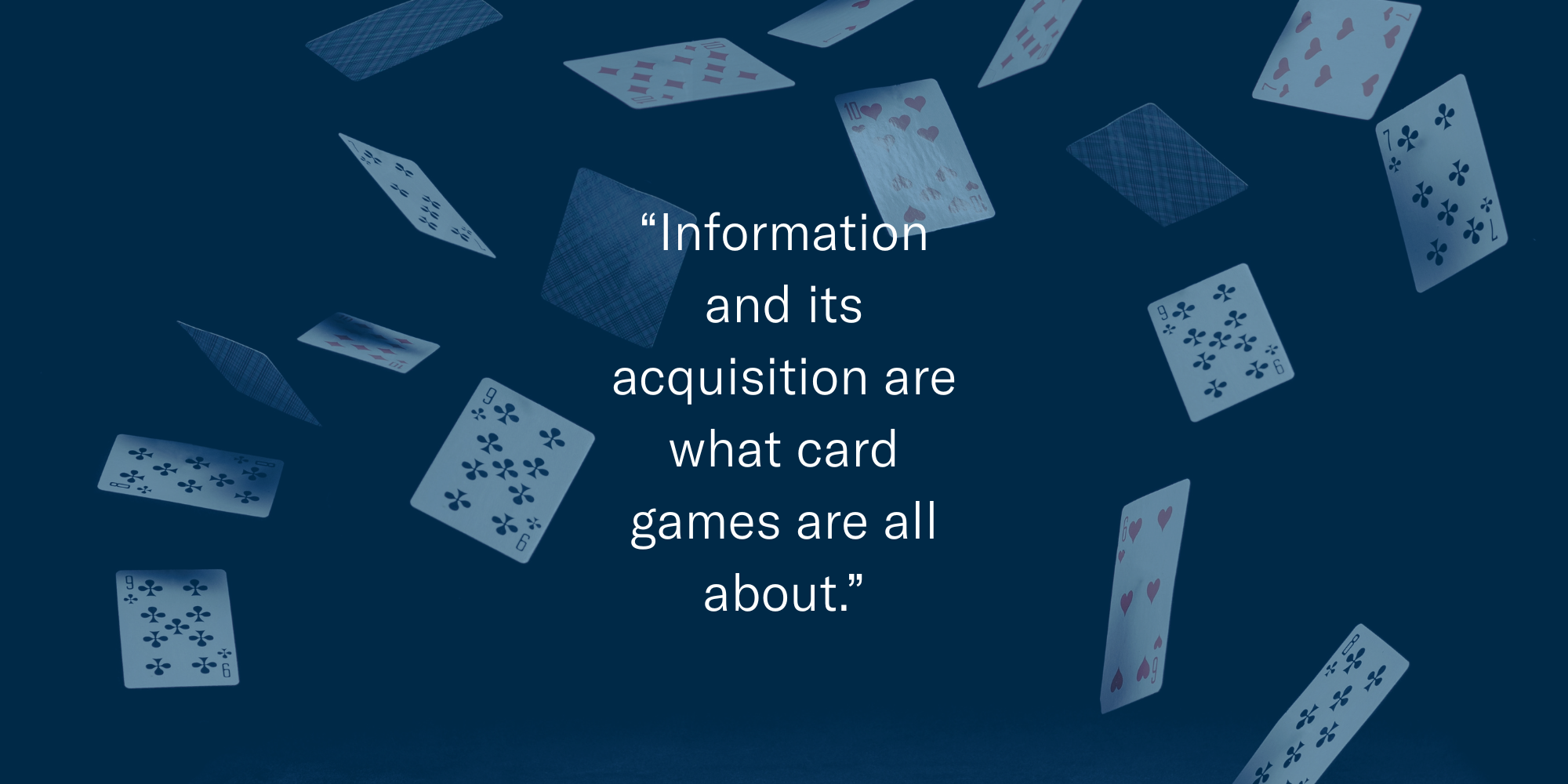
Severance is a textbook example of an imperfect information system. Perfect information occurs when everyone knows everything about the run of play in a game like Chess, where all the pieces are visible on the board. Games like Mafia, Magic: The Gathering, and Poker are much more like Severance, where all of the players only possess pieces of the total picture.
The designer’s choice to create a system with imperfect or perfect information is incredibly consequential and impacts the strategies players enact during the course of play. “Imperfect information invites treachery, trickery, and deception, and can be used as a design element in games meant to inspire mistrust among players,” write Salen and Zimmerman.
Digging deeper, Celia Pearce outlines four ways information manifests itself in games. We can use Poker to illustrate: There is information known to all players (the face-up community cards), information known to one player (the cards in your hand), information known to the game only (the order of undealt cards in the deck), and randomly generated information (the shuffle before each hand).
Severance takes advantage of each type of information to drive its plot. All players know the basic structure of Lumon Industries and its severance procedure. Helly’s true identity as the daughter of Lumon’s CEO is known to only one player, outie Helly. The true purpose of Macrodata Refinement’s sorting is known only to the game (aka the writer's room of the show). Randomly generated information is the “scary” numbers, or why some are sent to The Break Room.
But understanding how Severance manipulates what characters know only gets us halfway there. The show's real treasure isn’t just access to information and how information functions as the narrative's primary building material. This brings us to a different way of thinking about information—not as content to be revealed or concealed, but as the fundamental architecture of uncertainty.
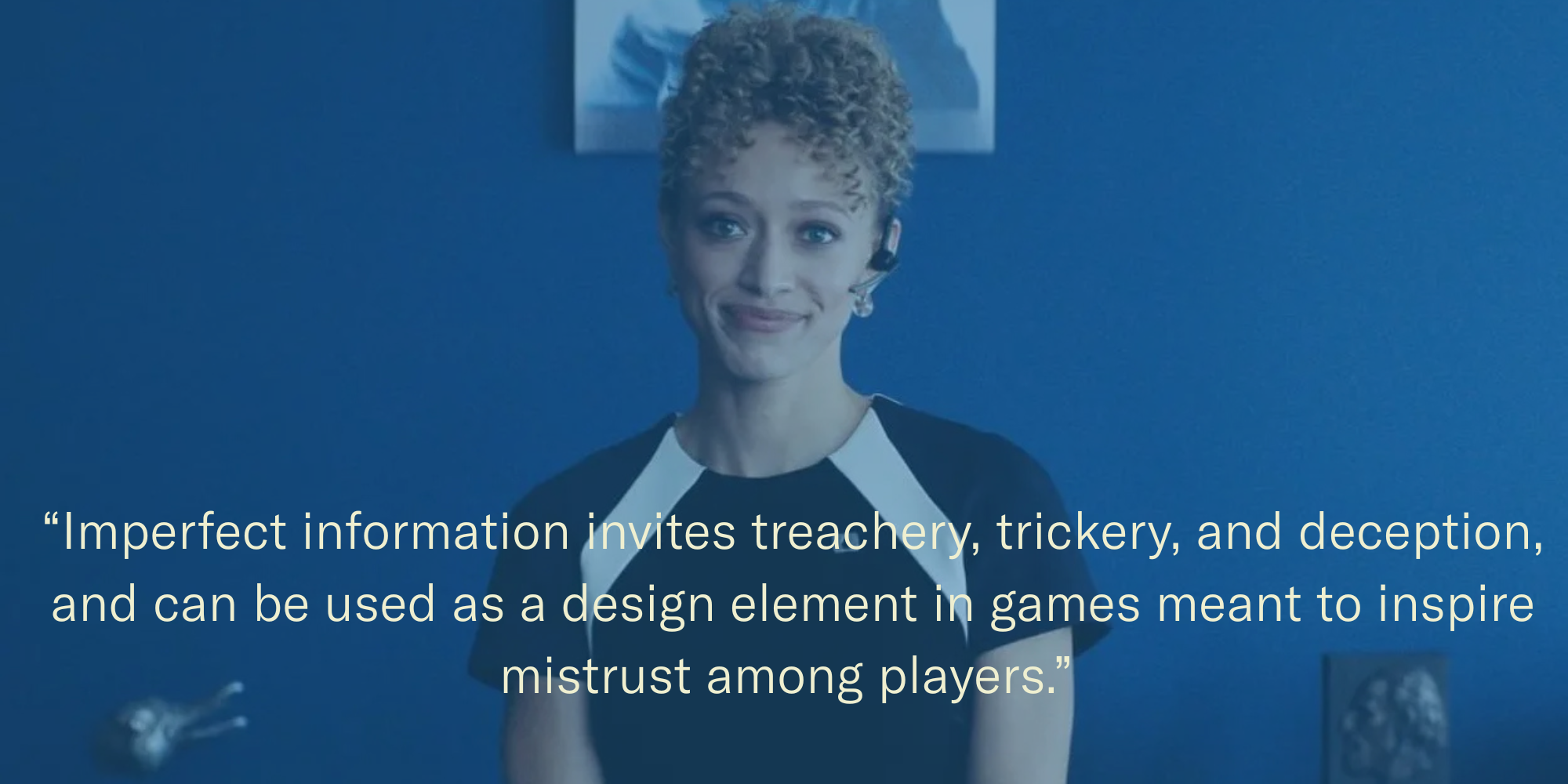
Wellness Sessions
Information as a structure comes from the information theory world, but how information theorists use the term differs from how one might think. Information in this context is a condition, not “stuff that I know.” Quoting communication theorist Stephen W. Littlejohn, here’s how to think about it: “Information is the measure of uncertainty in a situation.”
Salen and Zimmerman use the example of asking questions of a fictional friend, J.L. Asking them, “Did you eat breakfast this morning?” has low informational content because there are only two possible answers: yes or no. Asking J.L. what their favorite word is has high informational content because there are 1 million possible answers. So J.L. telling you their favorite word is really important, because there are many possible answers.
In Severance, we find that the makers play with information similarly. The use of color in Severance is actually a low information signal. When asked about the meaning of blue and green on the show, Stiller was dismissive that it was anything more than an aesthetic choice.
I don’t sit around and talk about those thematic ideas. When we were creating the office, we had to decide on the color of the carpet. We will live with this carpet for many years, if the show goes on. I’d never made a series before. So I thought, Let’s make sure we like this color green. But then it becomes the world that we live in.
Stiller liked how it looked. That’s it. You may suspect he is lying or generate your own hypothesis, but when the puzzle maker shows their hand, believe them!
Conversely, the Lumon company handbook and its bizarre corporate procedures provide a wealth of high informational possibilities. Unknown rules about their work environment abound. The mandatory wellness sessions and obligatory “Music Dance Experience” protocol play with our understanding of what’s possible because there’s so much about Lumon that we do not understand. There’s a fine line between capricious and calculated.
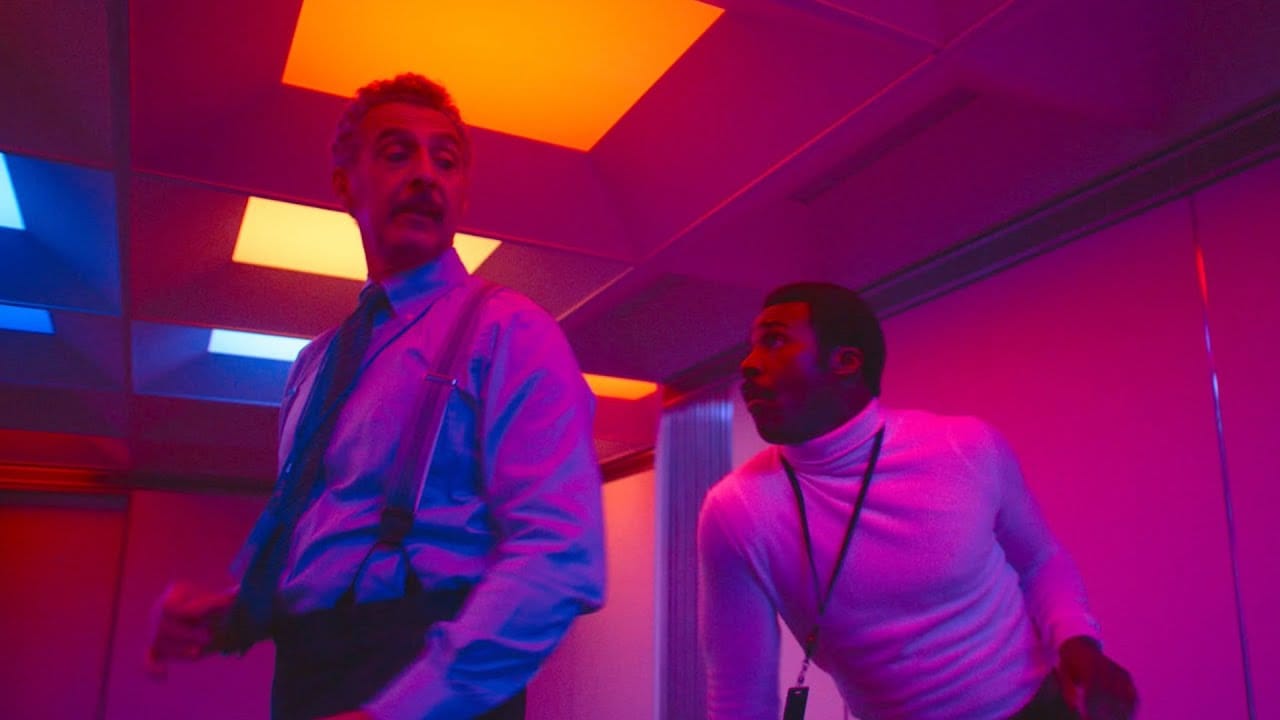
Salen and Zimmerman’s second quality of information is that it “does not refer to a message, facts, or meaning. It is a concept bound only to the quantification of stimuli or signals in a situation.” Think about two different computer passwords: nmksjdflk and adventure. Both are nine-letter strings. While we are tempted to say that adventure has more information, this is just another set of nine letters in information theory.
Or consider a game like Wordle. You are given five blank spaces and must guess a word that fits. Each guess reveals two pieces of information–whether you have the correct letter (low informational content because there are only 26 choices) or the correct word (high informational content). But if we changed the letters to numbers (this is how you play the game Mastermind), the amount of information actually decreases, as there are now 10 choices for each space for numbers 1-10, instead of 26 letters, and the correct answers go from 1 million words to just 100,000 numbers. The point is that the structure of the information has remained unchanged (five blank letters) even though the content can make a world of difference in how the game feels.
Severance plays with a similar structure by taking familiar objects and presenting them to innies who lack context. Innies respond well to Ricken’s milquetoast affirmations, but don’t really understand why they’re so meaningless. Gretchen shows innie Dylan a picture of their family together, but the emotional content is gone since it's not a memory that innie Dylan possesses. We recognize the quarterly progress rewards of pencil erasers and finger traps as the meaningless “Employee of the Month” baubles given at actual workplaces. Still, for innies, these are dead-serious perks. Severance manipulates the affective content of everyday objects—one meaning for us and the outies and another for the sterile world of the innies.
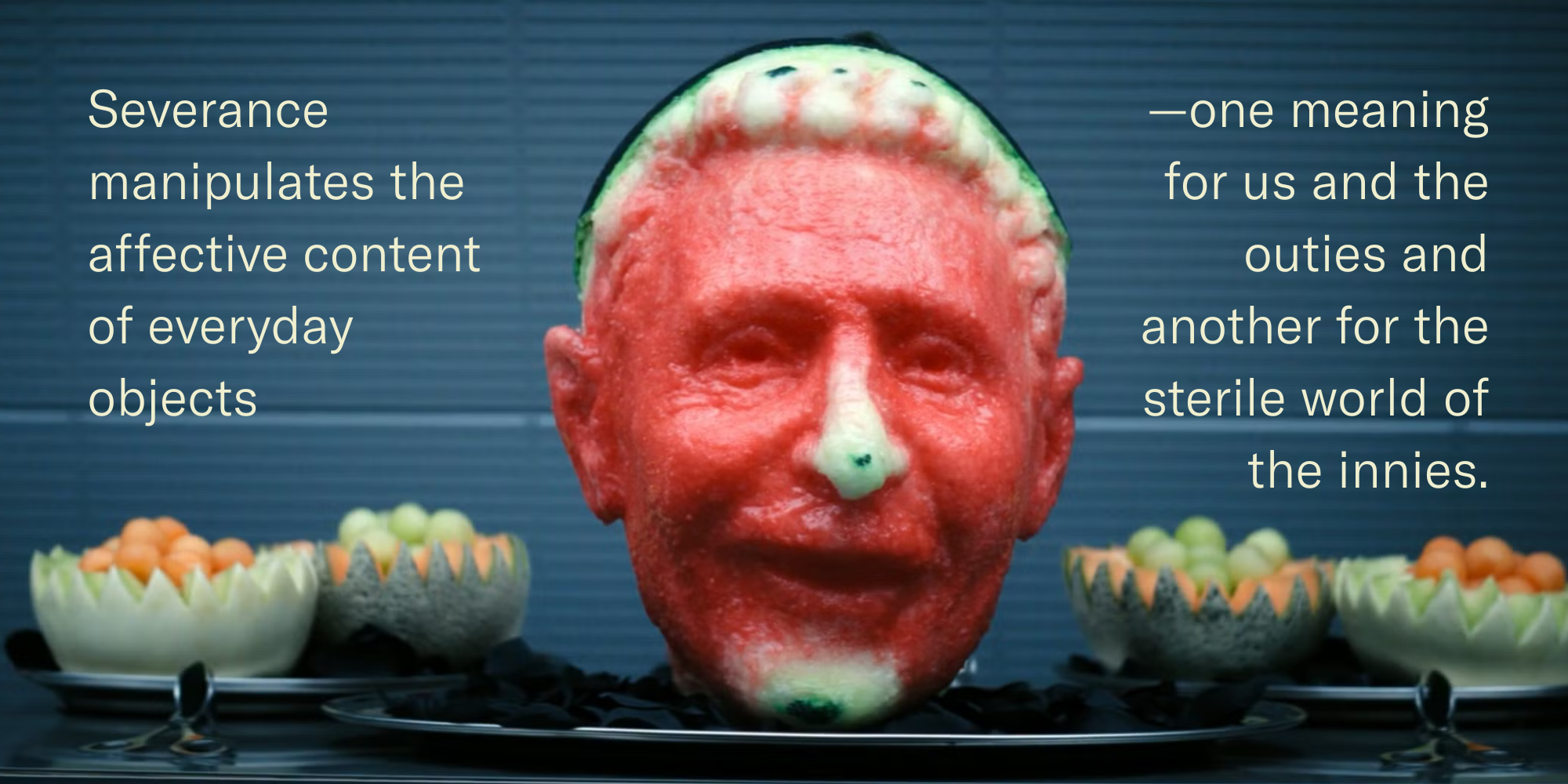
Break Room Protocol
The last dynamic of information as structure is what is called noise and redundancy. Noise distorts the transmission of information, like in the game of Telephone, where a simple phrase degrades with each whisper. The joy is in the outcome as the original phrase has completely transmuted. In Papers, Please, Lucas Pope deploys noise to force players into a state of confused moral conflict. The cluttered paperwork, overlapping documents, and time pressure create informational chaos that mirrors the busy work of authoritarian border control.
Redundancy helps balance out the use of noise. As in the game of Telephone, the English language structure allows people to decipher the original phrase by filling in the blanks and understanding the possible answer. Likewise, games with strong visual communication approaches like Journey and Monument Valley abandon language altogether, showcasing what can be done without noise.
Game designers like using noise and redundancy to balance information structure in their work. Too much noise and the work becomes indecipherable; too much redundancy and one runs the risk of simplification. Salen and Zimmerman explain that this balance “requires tuning a communication system so that there is enough uncertainty to ensure a sufficient amount of information passing through the channel, but not too much information, so that the signal does not confusing language and nod to the complicated politics of respectability get lost in vast oceans of uncertainty.”
In Severance, we find that balance between these two concepts, specifically through the semantic game of language of its characters. Natalie is a chipper cipher with corporate jargon who transmits the supposed intent behind the Board’s silence. Ms. Casey’s wellness sessions are dotted with stereotypical self-help slop that disguises her real identity alongside her hidden pain of separation. Milchick’s performance review dings him for “using too many big words,” a jab at the show’s confusing language and an obvious nod to the complicated politics of respectability BIPOC professionals must navigate to get ahead. In all of these interactions, the characters are balanced between obscure enough to preserve the mystery without becoming unintelligible.
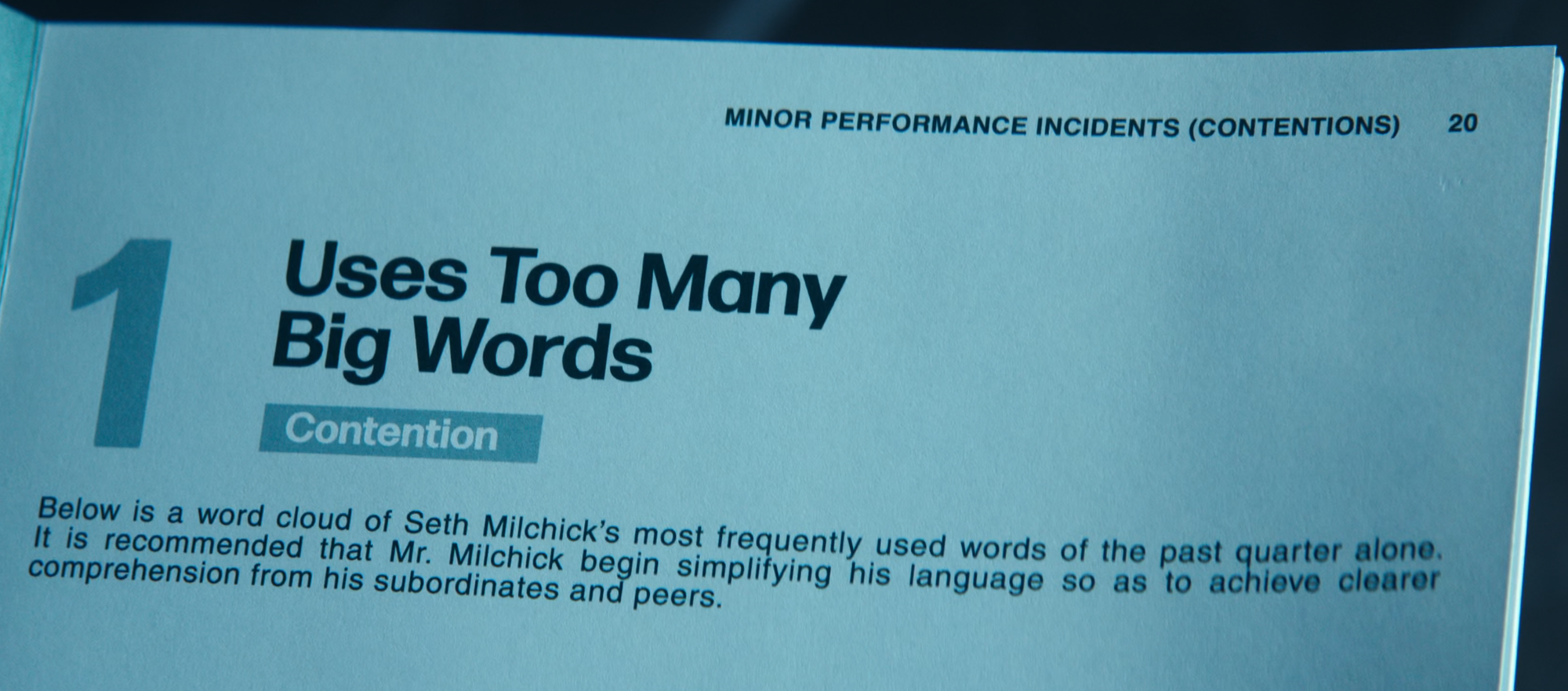
In all, Severance’s disciplined approach to information as a structure is part of the show's appeal. Littlejohn writes about the importance of information: “When a problem is completely predictable, no information is present,” a line that could be pulled from Keir’s own writing. But if the problems of Severance were predictable, it wouldn’t be much of a show.
Severance succeeds not because it borrows from games, but because it understands what games have always known: that meaning emerges from the careful management of what we don't know. In a culture increasingly obsessed with transparency and total information, the show reminds us that uncertainty isn't a bug—the feature makes us human. Maybe we ask Kier to add it to the Four Tempers.





